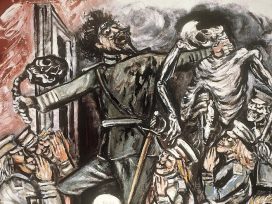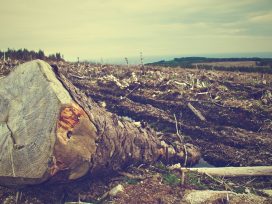For all its acuity, John Keane’s theory of democide risks confusing democratic degradation with a transformation of the political debate. Not only that, it fails to account for the radicalization of authoritarian systems once democracy has been killed.
John Keane’s essay How democracies die, fast and slow reflects on the multiple manners and various velocities with which democides unfold or are committed. His essay sketches with great panache the catastrophic scenario of instant democratic death; the lentissimo version of worsening agony through ‘gradual cuts’; the ‘auto-immune disease’ of democracy leading to the rise of a despotic form of ‘phantom democracy’; the neglect of the social and civil societal foundations when indignities undermine citizens’ capacity to take an active interest in public affairs, ultimately triggering destructive feedback loops; and – last but certainly not least – the adagissimo version of democide via the despoliation of our planet and ecological shocks. Keane explores these five paths through wide-ranging insights, theoretical inventiveness and poetic refinement.
In his recent books on the history and present of democracy and its alternatives (The Life and Death of Democracy; The Shortest History of Democracy; To Kill a Democracy; and The New Despotism, among others), Keane has shifted attention away from the rather stale, nearly obsessive mainstream concerns with liberal democracy and populism. Here, too, he employs less common and more intriguing key concepts, such as monitory democracy, democide, despotism or anthropocentrism. The author’s application of these concepts and his delineation of the abovementioned five paths are captivating. The central purpose of his essay is clearly spelled out: ‘these different rhythms need to be identified and understood, not because of some perverse fixation on morbidity but, rather, to equip the friends of democracy with an early warning detector, to help them anticipate and deal with its degradation and work for its defence and renewal in nuanced and plural ways.’
Having stated all this, I argue that Keane’s typology of democide should at best be used as a flexible tool to study complex cases empirically rather than as a rigid instrument of their categorization. Ideal types can be useful as models, but pure cases are exceedingly rare in practice. Historically, the different types, rhythms and paces of change cannot be neatly separated from each other. Nuanced debates about the life and death of democracy instead need to address the interactions between transformations of different kinds and speeds, and their relative causal weight in cases of ‘democide’. Even this concept may be too homogenizing to be of sufficient precision.
Finally, Keane’s rather polarized focus on democratic ideals, on the one hand, and democide, on the other, risks misdiagnosing the current political condition. In numerous polities across the globe, we might be seeing something more mundane, if partly novel: an ongoing transformation of democracy, which can be rightly criticized as a degradation. However, the return of heavy-handed politics, crude propaganda, and a general vulgarization of public life can in many cases also be viewed as parts of democratic debate under changing conditions.
Democracy can be defined both as the legitimate exercise of power via the consent of the governed and as an open debate over what the legitimate exercise of power consists of. In other words, it is both a system of rules and a debate about the rules. This points to the largely unresolvable conundrum one faces when participating in and analysing democracy, understood as an unfinished project of emancipation in which practically any issue may be politicized. Here, no one can claim to be above the fray; every analyst becomes an active participant, just as every participant is also a practicing analyst.
The tensions associated with epistemological egalitarianism are likely to become more acute in the Anthropocene and under conditions of digitalized capitalism. Grappling with the climate emergency will only make the dual nature of democracy more apparent. It will make the meaning and implications of democracy more contested too.

Street art by Hungary’s ‘Two Tailed Dog Party’, drawing attention to the government’s neglect of public services. Source: Wikimedia Commons
Interacting layers
While Keane’s typology certainly helps us draw analytical distinctions and illuminate crucial processes in a more nuanced fashion, its major downside is that it artificially separates alternatives and neglects how the various paths to democide reinforce each other in concrete instances.Take the most widely discussed death of democracy in the twentieth century: the collapse of the Weimar Republic. It would be relatively easy to demonstrate that the first four scenarios Keane sketches all played out in Germany at around the same time, if indeed at different speeds.
The enabling act of 1933 amounted to the crime of instant murder (Keane’s first type of democide), but this sudden act came on top of a more gradual assault in the final years of the Weimar Republic (type two). The creation of the so-called Volksgemeinschaft, an ethnic-racial community under Nazi rule, may be characterized as an exclusionary, peculiarly despotic, and utterly violent and brutal form of phantom democracy (type three).
This phantom democracy – a revolutionary-expansionist dictatorship in the name of popular rule for the titular majority – was attempted once the social foundations of democracy had been severely eroded. Profound war trauma, the widespread sense of national humiliation, imperial and racial fantasies, the rise of political violence, the shock of spiralling inflation and the indignity of mass unemployment combined to devastating effect (type four). All these developments have been central to the historical discussions of the rise of Nazi Germany for decades.
Many would add that any analysis of democide in a solely national frame is bound to be insufficient. The apparent crisis of liberalism in the Weimar Republic turned into agony with the Great Depression, which began on the other side of the Atlantic and arguably did more to seal the fate of Germany’s first democratic experiment than any other factor. Keane cites Karl Polányi’s insight that democracy is ‘at odds with unbridled capitalism’ but does not attempt to connect the fortunes of democracy to economic cycles. However, without the slump in global capitalism, it is highly unlikely that Adolf Hitler would have been able to crush democracy in an industrialized and militarized state in the middle of Europe – the kind of modern German state which, speaking of the longue durée, it took the effort of numerous generations to build.
Fernand Braudel did more than any other historian to popularize the notion that history consists of processes with various durations and velocity. His point was that they need to be related to each other when we develop our interpretations, from the longue durée almost imperceptible to the eye to what Braudel thought of as the surface structure of events.
Keane’s analytical distinctions between types and speeds can help us grasp the different layers of the process that led from democracy to dictatorship in interwar Germany. However, the truly vexing empirical question for any historian is how these interacted with each other and what their relative weight ultimately was. How did the erosion of democracy’s social and civil societal foundations interact with Hitler’s polycratic, chaotic, and radicalizing revolution from above? Political and social historians are likely to place their emphases differently. But both are well advised to incorporate the findings of the other into their own.
Transformations in ‘the great beyond’
Let us look at a more contemporary, if much less dramatic and devastating example: Viktor Orbán’s regime in Hungary, which analysts attribute to having established the first illiberal state in the European Union. Hungarian democracy has clearly experienced worsening agony through gradual – and legalized – attacks over the past thirteen years or so (Keane’s second type of democide). This has resulted in the ‘zombification’ of accountable government – Keane’s ‘strangely despotic form of phantom democracy’.
There is much evidence that the rightwing populist breakthrough in the country started earlier than 2010 and that large segments of Hungarian society were dominated by such political forces prior to Fidesz acquiring its first parliamentary supermajority in the elections that year (type four). In other words, while it took a revolution from above to make wide-ranging institutional changes, societal commitment to democracy had been gravely eroded by the time Orbán and his coterie launched their gradual and methodical revolution.
The Hungarian prime minister’s single most cited speech, delivered in Romania in 2014, announced his ambition to build an illiberal state in Hungary. This speech has perhaps been referred to so frequently because it has come closest to an explicit declaration of intentional democide – Keane’s first type. (This Hungarian-language speech has often, and rather euphemistically, been misquoted at international fora as if Orbán had spoken about illiberal democracy, but that is another story.) Moreover, not unlike the case of democide in inter-war Germany, the success of the Hungarian regime’s illiberal Doppelgänger to democracy had an economic context: the global economic crisis, which impacted on Hungary particularly heavily from 2008–09.
It would be futile to try to identify the process of de-democratization in Hungary with one mode and speed. The gradual phantomization of democracy that has placed the country on a slippery slope towards authoritarianism; the experience of an unprovoked legal onslaught from above led by a skilled and manipulative politician, resulting in a heavy concentration of power; the decades-long radicalization of society, which has yielded an increasingly resigned sense among supporters of democracy that the local-national foundations for its revival are largely absent; the relatively fortunate economic trends of the 2010s combined with generous EU subsidies that were easy for state actors to capture; the mass emigration of liberal strata (the preference for ‘exit’ over ‘voice,’ to cite Albert Hirschman) – all have combined in Hungary to produce a rare occurrence of massive de-democratization from a high starting point. It shows that democracy can never be assumed to have been ‘consolidated’.
The conclusion should be clear: if each of the first four types suggested by Keane are examined in connection, while also considering global economic trends, we can usefully analyse these two infamous cases. At the same time, crucial differences between the actual outcomes in the two cases should be evident too. And those differences in turn ought to make us question the precision of Keane’s key concept of democide.
As the Weimar example illustrates, democide may result in expansionist and self-destructive wars of annihilation within just a few years. But as Orbán’s regime within the EU shows today, de-democratization may also lead to a machinery of calculated ambiguity, conscious provocation and rampant corruption bent on co-opting or quietly disabling alternatives. The Nazi regime persecuted masses of innocent people. The Orbán regime does its best to protect the not-so-innocent few.
It is not that these two cases belong to distinct types of ‘democide’ so much as that the meanings and consequences of those ‘democides’ dramatically diverged. If anything, Hitler’s mass dictatorship with its violent aspirations of a total transformation and Orbán’s nasty though bloodless phantom democracy should be placed at the opposite ends of the spectrum of anti-democratic projects (though I would not rule out further radicalization of the latter regime in the coming years).
Keane is at his finest when enumerating populist tricks (‘threats and bribes in backroom meetings, dinner deals with business oligarchs and media tycoons, court victories, state-of-the-art media dog whistling, troll factories and message bombing, calculated silence and brute force’) and how they can result in a despotic, corrupted state ‘led by a demagogue and run by state and corporate poligarchs with the help of pliant journalists and docile judges, a top-down form of government backed by the combined force of the fist and the voluntary servitude of millions of loyal subjects.’ But I am less convinced that his concept of democide can explain the massive divergences just mentioned. The point Keane seems to be missing is that, after death, democracies can transform into various things in ‘the great beyond’.
Existential judgements
In our age, democracy has taken the form of monitory democracy, writes Keane; democracy is ‘periodic elections plus a plethora of watchdog bodies that publicly scrutinize, check, and restrain those who exercise power.’ For Keane, contemporary democracy means the protection of society against predatory power, and implies the rejection of racism, misogyny, caste and religious bigotry and all other types of human and non-human indignity.
Keane also asserts that ‘to live democratically is to refuse the dogma that things can’t be changed because they’re “naturally” fixed in stone.’ Democracy is about ‘free access to information and a learned sense of worldly wonder. It’s the everyday ability to handle unexpected situations and make judgments wisely,’ he adds.
Keane thus correlates democracy with intellectual openness and sophistication, a certain moral firmness and universalism, but also with a degree of epistemological scepticism – qualities I personally find profoundly attractive and consider essential to democratic politics. Keane also notes, more pessimistically, how democracy can degenerate into empty spectacle, dirty tricks, and vote harvesting – a pattern readers in practically every country would have no problem in recognising. However, these two points might be more closely related than he acknowledges. If those in favour of more ambitious versions of democracy sound too sophisticated and elitist, that might leave more antagonistic and robust understandings of democratic competition to those who end up worsening the quality of democracy.
What Keane similarly fails to address is the epistemological disorientation one experiences in a democracy whose quality is worsening. He seems to be saying that there are ‘genuine experiences’ of being ‘disesteemed’ (James Baldwin), on the one hand, and the ‘political seduction of the disaffected’ by the false friends of democracy on the other. I am genuinely puzzled how and where exactly to draw the line between the two. It seems to me that political subjectivities are formed by the constant interaction between what we might call our direct experiences of the world and the scripts we apply to interpret those experiences. Contemporary trends in digitalization, including the rise of surveillance capitalism, only make it more evident how profoundly intertwined and inseparable the two are – just how political the personal aspects of our lives are.
This rather abstract consideration is of great practical import, I believe, not least since – as Keane admits – there are moments when democracy ‘implies the need for insurrection’. The moot question is how we can safely tell that such a need has arisen, or whether people have only been made to believe so by ‘false friends of democracy’?
A modicum of epistemological scepticism leads me to believe that no metapolitical and metahistorical answer can be given. Whether an insurrection is viewed as legitimate or even justified requires political judgement concerning specifics. It requires a type of judgement that is often of an existential character.
Such questions simply cannot be decided in abstract terms in advance.
Unwitting suicides?
If much of Keane’s essay is about sketching ‘ideal types’ of democide (in the Weberian sense), his subsequent reflections on democracy sound idealized in the more mundane sense of the word. ‘Democracy is tenderness with children and respect for women and people of different sexual preferences. Democracy is humility. It is the willingness to admit that impermanence renders all life vulnerable, that in the end nobody is invincible, and that ordinary lives are never ordinary,’ he writes.
Such splendid passages are indicative of what might be the single most remarkable aspect of John Keane’s reflections: his opposition of democracy and power. It is conventional and indeed almost tautological to view dictatorial regimes as the triumph of power unchained. It requires more counter-intuitive thinking, and more than a dose of idealism, to link democracy to self-restraint. With some exaggeration, we might capture this specific vision of democracy’s telos through the slogan ‘no power to anyone!’
Such a vision of democracy has confounding implications regarding the climate emergency. Keane depicts the greening or earthing of politics as something new in the history of democracy, ‘an important political trend driven by the invention of scores of new media-savvy forms of public monitoring and representation of our planetary ecosystems’. He is quick to add that extreme environmental shocks may also come to normalize emergency rule. In the name of their safety and security, people might soon get used to the permanent administration of their lives and to ‘compulsory solidarity,’ he warns.
Here there seems to be a mismatch between means and ends. We need more than just a measure of self-restraint, and quickly at that, to reduce the grave risks and deadly impacts caused by climate change. The central ambition of Keane’s democratic way of life, that of reducing human power to a minimum, may indeed offer the most suitable means on one level.
However, there is another level which has to do with the urgency of the transformation and the predictable slowness of democratic change. Wealthy and well-functioning participatory democracies prefer extensive negotiations and gradual steps, reject imposed conformity, and allow people to pursue their pluralistic preferences. When it comes to abruptly transforming people’s ways of life and material habits, high-quality democracies may prove grossly inadequate.
The climate emergency thus poses Keane’s central question to us in a different way: what if democracies flourish and thereby unwittingly commit suicide?
Our most urgent task
Let me close by returning to the present. Shocking and highly consequential negative trends notwithstanding (think, of the criminal brutalization of Putin’s regime in a country that has never enjoyed the benefits of monitory democracy, or the deeply worrying developments in contemporary India, often naively praised as the world’s largest democracy), I would argue that our contemporary democratic malaise has to do with the still poorly understood transformation and worsening quality of democracy. Pace Keane, we are living neither in an age of widespread democide, nor one of democratic progress towards more generalized forms of humility and tenderness.
Conceiving a post-anthropocentric future for democracy – which Keane rightly labels ‘the most anthropocentric ideal ever conceived’ – indeed sounds like our most urgent task. However, to grasp its ongoing transformation and possible future, we need to approach democracy not so much as a question of universal norms and values, but as an urgent historical and empirical problem. Reconsidering democracy as a form of government while pondering our worsening challenges in the Anthropocene will force all of us to realize – as Keane argues – that there is no transhistorical standard of democracy.
As we still cherish the moderation, intellectual openness, and epistemological scepticism this exceptional theorist associates with monitory democracy, we now also need the radical self-assertion of free peoples in the interest of collective self-restraint.
Published 14 April 2023
Original in English
First published by Eurozine
© Ferenc Laczó / Eurozine
PDF/PRINTPublished in
In collaboration with
In focal points
- Living dead democracy
- Why Parliaments?
- Spelling out a law for nature
- No more turning a blind eye
- The end of Tunisia’s spring?
- Protecting nature, empowering people
- Albania: Obstructed democracy
- Romania: Propaganda into votes
- The myth of sudden death
- Hungary: From housing justice to municipal opposition
Newsletter
Subscribe to know what’s worth thinking about.
Related Articles

Four months into Trump’s second term and the president’s ICE raids on immigrants, triggering protests in Los Angeles now under troop surveillance, prove that ‘democracy is under assault’. Could a historic courtroom reprimand provide the necessary guidance for a moral reset?

Since the collapse of Novi Sad’s train station in November, student-led protests have erupted across Serbia, inspiring a nationwide movement against corruption.











